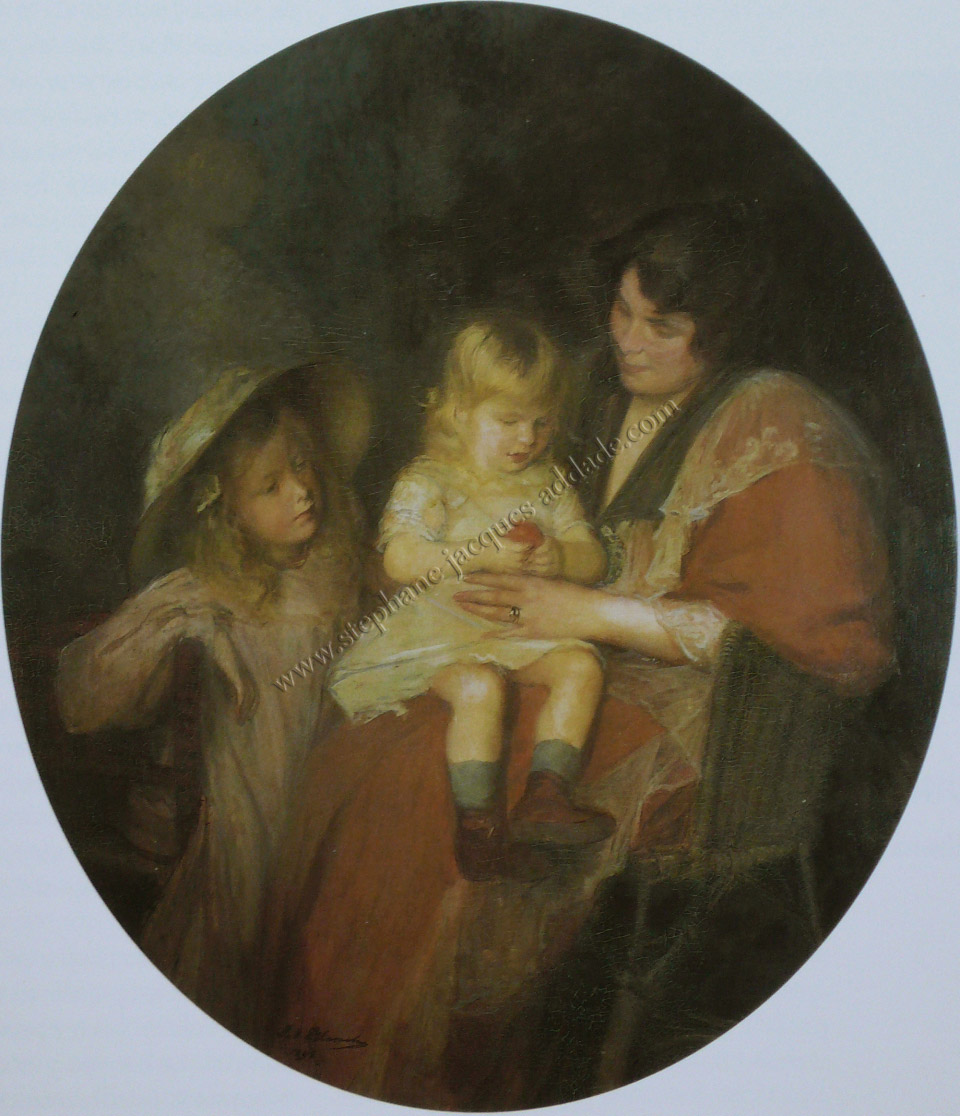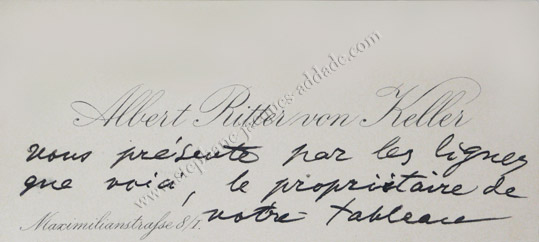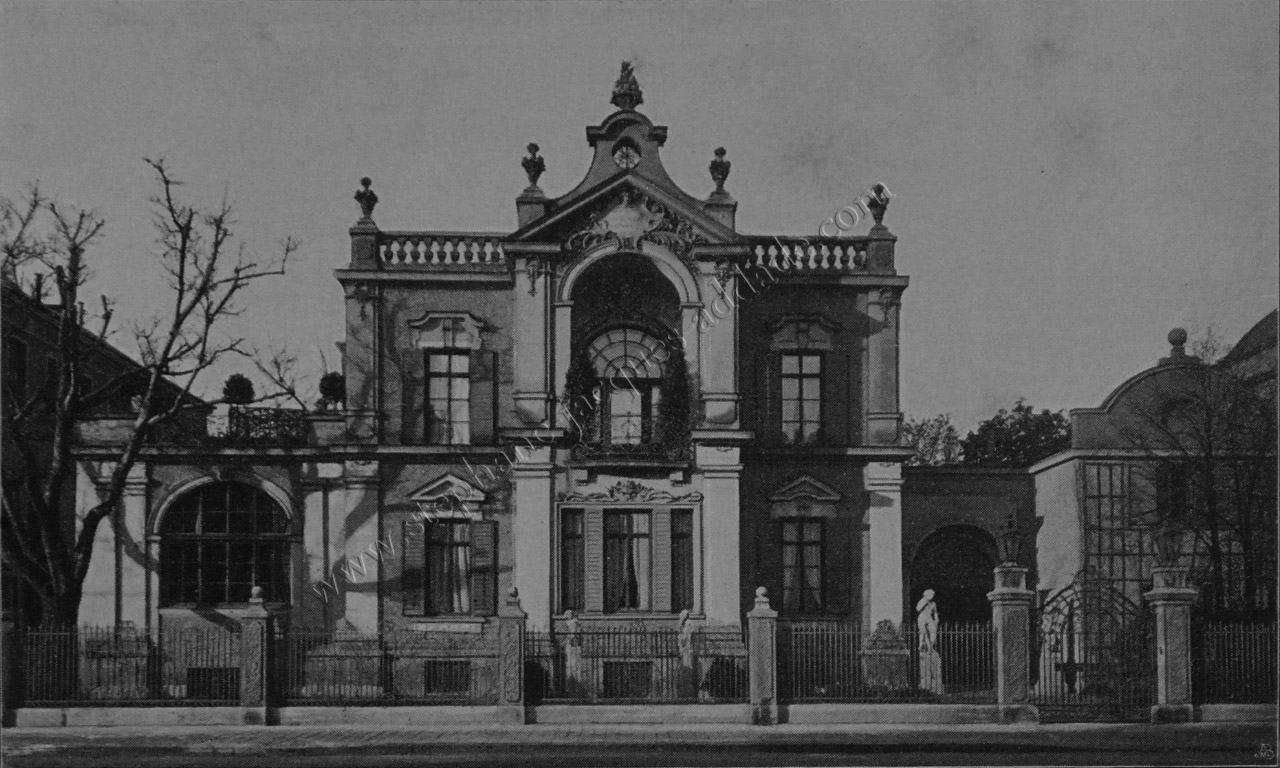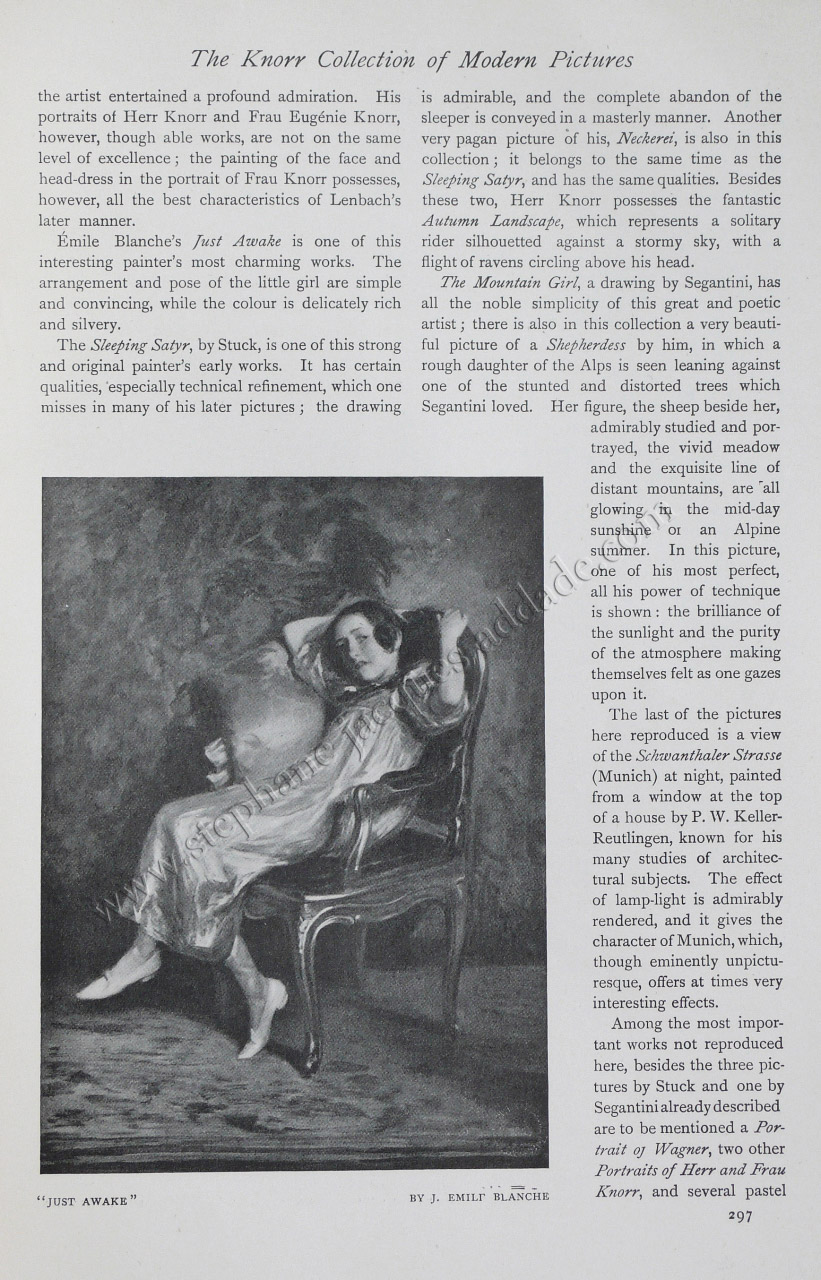
JUST AWAKE OR WAKING THE SENSES
22 April 1903.
The fifth Biennale de Venise (Venice Biennial) opens its doors.
French painter, Jacques-Emile Blanche, has been regularly invited to exhibit by this institution since the second edition of the event. This year he is presenting eight paintings, including three Etudes pour Bérénice (Studies for Bérénice), Le Chérubin de Mozart (Mozart's Cherub) - another painting of Bérénice – a Portrait of Philippe Barrès, son of the writer and politician Maurice Barrès, and finally Risvegio, a work listed under number 5 in the catalogue and repeated on page 10


Risvegio or Just awake, which had been painted in 1900, and which, by 1903, already no longer belonged to Jacques-Emile Blanche, was immediately considered by the critic, and the painter himself, to be one of his masterpieces. Moreover, the painting, which certainly wasn't unfamiliar to the general public, having been duplicated over and over for the cover of the special issue Figaro Illustré from October 1902 (1) – an issue entirely devoted to Jacques-Emile Blanche and drafted by Maurice Barrès(2) – had already been exhibited several times and had been the subject of some lengthy negotiations, just a year after its creation.

A highly coveted work
Indeed Réveil (Just awake) was discovered on 22 April 1901, during the inauguration of the XIth Salon put on by the National Society of Fine Arts, which was the most prestigious of the Parisian shows. It appeared here under number 107 and the title, Réveil (Just Awake), which was to stay with it forever, alongside the famous group portrait of MM. André Gide, Rouart, Chanvin, Ghéon and Athman Ben Sala at the Trocadéro (1900 exhibition), which is today kept at the Musée des Beaux-Arts in Rouen.
Here, Mr Ralph Brown, brother of the famous painter John Lewis-Brown and inspector of the Beaux-Arts in the city of Paris, noticed it straightaway and suggested he purchase it for the Petit Palais, which he planned to turn into the city's museum of Fine Arts, as a replacement for the defunct Auteuil Museum (3).
Deliberation by the city council on 13 July 1901 backed this decision, which is confirmed in the Official City Report on Thursday 18 July 1901 (4).
An order, issued by the Seine's prefect and deciding on the purchase of the painting through this deliberation, was then made on 22 July 1901.
Moreover, the statement highlighting distribution of the credit allocated by the city council to Paris' Fine Arts department, tells us that the sum offered to Jacques-Emile Blanche for the purchase of his painting was reduced from 4,000 to 3,500 Francs and then ultimately 3,000 Francs!
Once these preliminary administrative discussions were finally complete, a headed letter from the Seine authority, signed by Ralph Brown, was finally sent to the painter – that same day on 22 July 1901 – to inform him of the "purchase" of his painting

« Sir,
I have the honour of informing you that by order of the prefect on 22 July, made in accordance with a city council deliberation on 13 July 1901, the City of Paris purchased your work exhibited at this year's show and, entitled "Réveil" for the sum of 3,000 Francs.»
It went on to warn him that:
«The City of Paris reserves the exclusive right to the works it commissions or purchases and no copy of your painting can be made without special authorisation from the administration.»
However firm the order was, it came a bit late!
Indeed, as soon as it was taken down from the National, on 30 June 1901, Réveil was sent by Jacques-Emile Blanche to Munich where it was to appear under No.31 1 (5), in the French section of the VIII Internationale Kunstausstellung, a prestigious art exhibition which was held at the Glaspalast, from 1 June till the end of October. Here it was displayed along with other French works of paramount importance, among which were Yvonne by Jules Lefèbvre and Procession à Penmarc'h by Lucien Simon, which today is kept at the Musée d'Orsay in Paris, as well as Eva Gonzalès by Edouard Manet, which is kept at the National Gallery in London.


An article by the famous Munich-based critic Fritz von Ostini (1861 - 1927), appeared in the art magazine, Die Kunst für alle (6) and was entitled "Die Franzosen im Münchener Glaspalast 1901 (7)", which features a copy of Réveil on page 30 et intitulé «Die Franzosen im Münchener Glaspalast 1901 (7) , under the title Das Erwachen (8) , accompanied by the caption "(Münchener Glaspalast 1901: Französische Abteilung (9) )". It confirms both the sending of the painting and its late arrival, which was a scenario echoed across the majority of the French works presented, as the two main Parisian Exhibitions had closed their doors a month after the exhibition was opened to the public in Munich (10) :
«Spät erst, anderthalb Monate nach Beginn der Ausstelung, sind die Franzosen eingetroffen. Dem Missbehagen darüber wird freilich der Stachel genommen durch die hervorragende Schönheit der Kollection, wie sie "spät, aber doch" zu stande kam. Was Frische, was strotzende Gesundheitsfülle angeht, bleibt auch jetzt noch die Palme der Ausstellung den Schweden, sonst aber, das muss man neidlos, oder neidisch zugestehen, kommt der französischen Abteilung des Glaspalastes keine andere gleich. (11) »

However, on 10 July 1901, immediately after Réveil was hung, Jacques-Emile Blanche received a telegram from the painter Albert Ritter von Keller (1844 - 1920) telling him about the purchase of his painting.
"De Muenchen Glaspalast - Congratulations. Painting sold and first medal. De Keller"
As such, when Ralph Brown's letter arrived at the end of July (12) , Réveil no longer belonged to Jacques-Emile Blanche by then.
However, the city of Paris remained attached to the idea of owning one of the painter's works and a substitution was finally decided upon, which ended up in a payment being made on 4 April 1903 – still by virtue of the city council's deliberation on 13 July 1901 – for La mandarine (fig 8), a portrait painted in 1898 of Mrs Fritz Thaulow and two of her children, Ingrid and Christian, which the Petit Palais Museum still keeps today (13) .

The Knorr collection
Via a calling card, which dated back to 8 August 1901 Albert von Keller gave Jacques-Emile Blanche information about the identity of the painting's purchaser:

"Albert Ritter von Keller / introduces you via these lines, to the owner of your painting / It's his 50th birthday (sic) which we're celebrating and if you feel like it, you can send him a card. Greetings"
What was the purchase price of the work?
Was Albert von Keller paid for being his intermediary?
Nothing in the correspondence from Jacques-Emile Blanche enables us to find that out.
 On the other hand, we do know that despite the lack of documentation accompanying Albert von Keller's calling card, that the man who treated himself to "Réveil" for his fiftieth birthday was the printer and publisher Thomas Knorr (1851 - 1911) (fig 10), the owner of "Münchner neueste Nachrichten"(14) and the satirical magazine "Jugend" (15) , who, on the death of his father Julius Knorr (1826 - 1881), took over the family publishing house with his brother-in-law, Dr Georg Hirth.
On the other hand, we do know that despite the lack of documentation accompanying Albert von Keller's calling card, that the man who treated himself to "Réveil" for his fiftieth birthday was the printer and publisher Thomas Knorr (1851 - 1911) (fig 10), the owner of "Münchner neueste Nachrichten"(14) and the satirical magazine "Jugend" (15) , who, on the death of his father Julius Knorr (1826 - 1881), took over the family publishing house with his brother-in-law, Dr Georg Hirth.
A famous collector, Thomas Knorr lived at Briennerstrasse 21 (the current No.37), a vast Renaissance-style villa (fig 11). Due to it being at the centre of artistic life in Munich, it was frequented by the writer Thomas Mann and, most notably, played host in 1864 and 1865 to the composer Richard Wagner. Consequently, when Thomas Knorr entrusted the architect Emanuel von Seidl (1856 - 1919) with the expansion and redevelopment of his villa, he decided to keep a summer house at the bottom of the garden, where the master put the finishing touches to Tristan et Isolde (16) .

Besides the furniture and the objets d'art, the very famous Knorr collection comprised over two hundred contemporary paintings in the early XXth century, the vast majority of which had been put together from the 1880s. In this way, two specially fitted-out galleries were used to hang the work in, and they housed paintings by Munich's main painters, such as Franz von Lenbach, Franz von Stuck, Albert von Keller as well as Julius Diez; as well as German masters such as Arnold Böcklin or overseas artists like Jan Toorop, James Jebusa Shannon, Jean-François Raffaëlli, Giovanni Segantini, Antonio de la Gandara and Paul Helleu.
When Réveil joined this prestigious set, Fritz von Ostini was just putting the finishing touches to the publication of a luxury piece of work which was entirely dedicated to him. Die Galerie Thomas Knorr in München, which was published at the end of 1901, thus contained a full-page plate copy of Jacques-Emile Blanche's painting. However, due to lack of time, there was no critique given to its study. He lamented this fact on pages 148 and 149, though he did indicate that he considered Réveil to be "one of the most precious works in the collection", whilst at the same time confirming what his article for Die Kunst für alle said about the purchase of the painting at the Glaspalast:
"In letzer Stunde wurde für die Sammlung, die sich überhaupt während der Verfasser diese Zeilen schrieb, um einige ihrer werthvollsten Nummern erst bereicherte, noch ein Bild von Jacques-Emile Blanche in Paris gewonnen, "Das Erwachen", das im Glaspalaste eben angekommen war. (17) "
 Five years later, in May 1906, it was Miss Costanza Hulton's turn to devote a long article to this "varied and cosmopolitan" collection in the English magazine The Studio – the most important art magazine of its day. The Knorr Collection of Modern Pictures (18), which provided succinct studies of the most emblematic paintings and reproduced, among eight others, that of Jacques-Emile Blanche, commenting on it with somewhat prudish enthusiasm:
Five years later, in May 1906, it was Miss Costanza Hulton's turn to devote a long article to this "varied and cosmopolitan" collection in the English magazine The Studio – the most important art magazine of its day. The Knorr Collection of Modern Pictures (18), which provided succinct studies of the most emblematic paintings and reproduced, among eight others, that of Jacques-Emile Blanche, commenting on it with somewhat prudish enthusiasm:
"Jacques-Emile Blanche's Just Awake is one of this interesting painter's most charming works. The arrangement and pose of the little girl are simple and convincing, while the colour is delicately rich and silvery. (19) »
So who exactly is this "little girl" with such a "convincing" pose in her silver dress?
Is it really possible to consider such a resolutely ambiguous painting as "charming", without the blindness of an excessive amount of very British primness?
These are just some of the questions we'll answer in the second part of this study.
(to be continued)
(1) Figaro Illustré Magazine No.151 October 1902. Jacques-Emile Blanche. (↑)
(2)Maurice Barrès "La femme et l'enfant par Jacques-Emile Blanche" (Mother and child by Jacques-Emile Blanche) in Figaro Illustré October 1902. (↑)
(3)Figaro 22 June 1901 Arsène Alexandre "A qui le petit Palais?" (For whom is the small Palace?). (↑)
(4) Official City Report from 18 July 1901 page 2665 Purchases of art works. (↑)
(5) A label bearing the handwritten caption "M. Blanche / Munich / n°31" (Mr Blanche / Munich / No.31) is still adhered to one of the uprights of the painting's stretcher. (↑)
(6) Die Kunst Für alle XVII Jahrgang, Helf 2 15 Oktober 1901, pages 26 to 35. (↑)
(7) The French at the glass palace in Munich 1901.(↑))
(8) Literal translation of Le réveil. (↑)
(9) Glass palace in Munich 1901: French section (↑)
(10) It's probably this delay with the French works that explains the lack of captions in the Offizieller katalog der VIII. Internationalen Kunstausstellung im Kgl. Glaspalast zu Münche 1901, the official catalogue for this event. (↑)
(11) "The French arrived very late, a month and a half after the start of the exhibition. The uneasiness was defused by the outstanding beauty of the collection, which ended up being presented as "better late than never". As regards the freshness and the bursting with vitality, the Swedish secured the exhibition prize, but this aside, we must readily concede, with some jealousy, that the French section of the glass palace is second to none." (↑)
(12)The painter then ended up holidaying in Saint Martin au Chartrain, in the Calvados, where the letter took a while to reach him.(↑)
(13) An accounting document from the Seine authority indicating that Mr Georges Veyrat, the new inspector of the Beaux-Arts (Fine Arts) department, made a payment on 4 April 1903 of 3,000 Francs for "the painting exhibited at the SNBA in 1901 and purchased by order on 22 July 1901" whilst the artist's record indicates, on this same date of 4 April 1903 "the purchase of his painting La mandarine" (The mandarin).(↑)
(14) The latest news from Munich (↑)
(15) "Youth: Munich's weekly art and daily life magazine" a literary and artistic review. (↑)
(16) You can still read on a plaque by Karl Oppenrieder, affixed in 1964 at Briennerstrasse 37: "Hier wohnte Richard Wagner vom 12. Okt. 1864 bis 10.Dez 1865 in einer Gartenvilla auf dem jetzigen Schulgelände" (Richard Wagner lived here from 12 Oct. 1864 to 10 Dec. 1865 in a garden pavilion situated on the current campus site).(↑)
(17) "At the last minute the collection was fleshed out – further enriched by some of the most precious works as the author wrote these lines – and included a painting by Jacques-Emile Blanche from Paris, Le réveil (Just awake), which had newly arrived at the Glass palace."(↑)
(18) The Knorr collection of modern paintings (↑)
(19) Description of Jacques-Emile Blanche's work 'Le réveil' (Just awake) in English in its original version (↑)
Dernière modification par Stéphane-Jacques Addade, le 23/03/2015